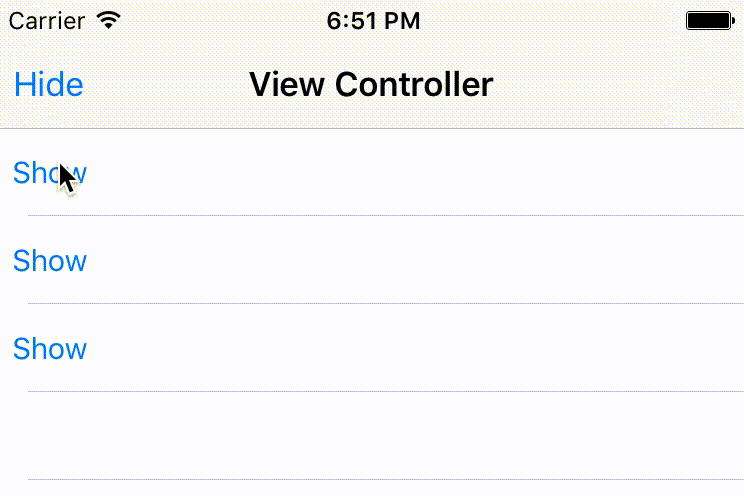Open UITableView edit action buttons programmatically
Apple has a private API that lets you do this, however, be warned that this may get your app rejected from the App Store unless you obfuscate the usage of said API using something like Method Swizzling. Here are the steps to do so:
Create a protocol called
PrivateMethodRevealerthat lets you access the required private Apple APIs, namely the ones to show and dismiss edit actions. Credits to this answer for providing this method of exposing private APIs. The methods in the protocol are declared asoptional, so that in case Apple changes the name of the method, the app will not crash, but rather, it'll just not show the edit actions.@objc protocol PrivateMethodRevealer { optional func setShowingDeleteConfirmation(arg1: Bool) optional func _endSwipeToDeleteRowDidDelete(arg1: Bool)}Note that although the methods refer to
delete, this shows all theUITableViewRowActions that are on the cell.Create a function that handles the showing and hiding of the edit actions in your
UITableViewCellsubclass (if you have one), or create the method in aUITableViewCellextension. I will name this methodshowActionsfor demonstrative purposes.Add the following body to your function:
func showActions() { (superview?.superview as? AnyObject)?._endSwipeToDeleteRowDidDelete?(false) (self as AnyObject).setShowingDeleteConfirmation?(true)}This firstly dismisses any visible cells' editing actions, by calling
_endSwipeToDeleteRowDidDelete:on theUITableView(which is the cell's superview's superview), and then shows the cell's own editing actions (by callingsetShowingDeleteConfirmation:). Note that we need to dismiss other cells' actions as showing multiple rows with edit actions is extremely buggy.If you want, you may also create a button in the
UIViewControllerthat dismisses any currently editing cells. To do this, just call the following method, wheretableViewis your reference to theUITableView:(tableView as AnyObject)?._endSwipeToDeleteRowDidDelete?(false)
If the swipe gestures between your UIPageViewController and UITableViewCells are conflicting, simply override the tableView:editingStyleForRowAtIndexPath: method to return .None.
In the end, your code might produce the following result
EDIT: Here is a quick way to hide the usage of your API using method swizzling. Credits to this website for providing the basic implementation of this method. Be warned that I can't guarantee that it'll work, as it isn't possible to test it live.
To do this, replace the protocols with the following code, and wherever you call setShowingDeleteConfirmation(true) or _endSwipeToDeleteRowDidDelete(false), replace it with showRowActions() and hideRowActions() instead. This method appears to have some unintended effects however, such as the UITableViewCells not responding to user interaction whilst edit actions are visible.
extension UITableViewCell { func showRowActions(arg1: Bool = true) {} public override static func initialize() { struct Static { static var token: dispatch_once_t = 0 } guard self === UITableViewCell.self else {return} dispatch_once(&Static.token) { let hiddenString = String(":noitamrifnoCeteleDgniwohStes".characters.reverse()) let originalSelector = NSSelectorFromString(hiddenString) let swizzledSelector = #selector(showRowActions(_:)) let originalMethod = class_getInstanceMethod(self, originalSelector) let swizzledMethod = class_getInstanceMethod(self, swizzledSelector) class_addMethod(self, originalSelector, method_getImplementation(swizzledMethod), method_getTypeEncoding(swizzledMethod)) method_exchangeImplementations(originalMethod, swizzledMethod) } }}extension UITableView { func hideRowActions(arg1: Bool = false) {} public override static func initialize() { struct Static { static var token: dispatch_once_t = 0 } guard self === UITableView.self else {return} dispatch_once(&Static.token) { let hiddenString = String(":eteleDdiDwoReteleDoTepiwSdne_".characters.reverse()) let originalSelector = NSSelectorFromString(hiddenString) let swizzledSelector = #selector(hideRowActions(_:)) let originalMethod = class_getInstanceMethod(self, originalSelector) let swizzledMethod = class_getInstanceMethod(self, swizzledSelector) class_addMethod(self, originalSelector, method_getImplementation(swizzledMethod), method_getTypeEncoding(swizzledMethod)) method_exchangeImplementations(originalMethod, swizzledMethod) } }}
I was on the same path as kabiroberai in finding a solution to this answer, but took a different approach with two separate protocols rather than one Objective-C/NSObject protocol that could potentially be misused. This also prevents having to make the protocol methods optional.
First, create two separate protocols to expose the private methods on both the UITableView and UITableViewCell. I found these by digging through the private headers of each class.
@objc protocol UITableViewCellPrivate { func setShowingDeleteConfirmation(arg1: Bool)}@objc protocol UITableViewPrivate { func _endSwipeToDeleteRowDidDelete(arg1: Bool)}In cellForRowAtIndexPath, keep a reference to the cell (or multiple cells) which you want to show the edit actions for:
class MyTableViewController: UITableViewController { var cell: UITableViewCell? // ... override func tableView(tableView: UITableView, cellForRowAtIndexPath indexPath: NSIndexPath) -> UITableViewCell { let cell = tableView.dequeueReusableCellWithIdentifier("Cell")! // ... if indexPath.row == 1 { self.cell = cell } return cell }}Now, fire the private methods. I used performSelector:withObject:afterDelay, or you can use a button.
override func viewDidLoad() { super.viewDidLoad() self.performSelector(#selector(showActionsForCell), withObject: nil, afterDelay: 2.0)}func showActionsForCell() { if let cell = cell { let cellPrivate = unsafeBitCast(cell, UITableViewCellPrivate.self) let tableViewPrivate = unsafeBitCast(self.tableView, UITableViewPrivate.self) // Dismiss any other edit actions that are open tableViewPrivate._endSwipeToDeleteRowDidDelete(false) // Open the edit actions for the selected cell cellPrivate.setShowingDeleteConfirmation(true) }}Calling unsafeBitCast directly is dangerous. For safety, check if your UITableView and UITableViewCell respond to those selectors, or make the functions optional.
In my case (swift 3, iOS11) MGSwipeTableCell works perfect. You can configure call's buttons in
func tableView(_ tableView: UITableView, cellForRowAt indexPath: IndexPath) -> UITableViewCell { let cell = tableView.dequeueReusableCell(withIdentifier: prettyIdentifier, for: indexPath) cell.allowsButtonsWithDifferentWidth = true cell.rightButtons = [MGSwipeButton(title: "Delete\npermanently", backgroundColor: #colorLiteral(red: 0.9745360017, green: 0.7205639482, blue: 0.3932176828, alpha: 1)), MGSwipeButton(title: "Undo",backgroundColor: .black)] cell.rightSwipeSettings.transition = .rotate3D cell.delegate = self return cell}instead of
func tableView(_ tableView: UITableView, editActionsForRowAt indexPath: IndexPath) -> [UITableViewRowAction]? {...}and catch touches in
extension RecordingViewController: MGSwipeTableCellDelegate { func swipeTableCell(_ cell: MGSwipeTableCell, tappedButtonAt index: Int, direction: MGSwipeDirection, fromExpansion: Bool) -> Bool { cell.hideSwipe(animated: true) // do your stuff here like if index == 0 { print("right button") } return true }}